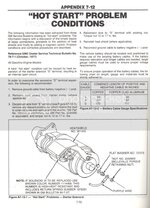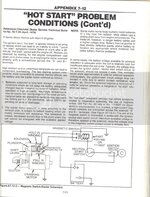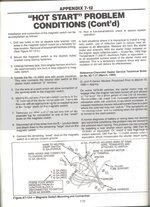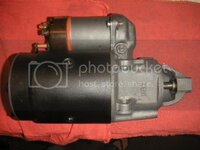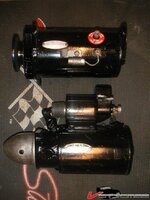You are using an out of date browser. It may not display this or other websites correctly.
You should upgrade or use an alternative browser.
You should upgrade or use an alternative browser.
Heat soaked starters/Myth or fact
- Thread starter big2bird
- Start date
big2bird
Charter Member, Founder Bird-Run, Cruise-In Bird-R
turtlevette
The Turdle
all this grief caused to millions of people because the dumb ass who designed the starter solenoid used wire that is too small.
its real simple and really stupid.
its real simple and really stupid.
kwplot34
Heart Attack
Where did you find that at Jeff? and i always thought it was because the internal parts of the starter expanded from the heat and thats what caused the hot start problem :bonkers:
And as always thanks to Turtle for his Technical explanation :goodnight:
And as always thanks to Turtle for his Technical explanation :goodnight:
big2bird
Charter Member, Founder Bird-Run, Cruise-In Bird-R
Where did you find that at Jeff? and i always thought it was because the internal parts of the starter expanded from the heat and thats what caused the hot start problem :bonkers:
And as always thanks to Turtle for his Technical explanation :goodnight:
I found that in an 84 Motorhome chasis book, but the story is the same. Jim's explanation is dead on.
The heat raises the winding resistence in the solenoid to where enough current to operate it cannot go thru the windings, ergo, too weak a magnetic field.
It actually has nothing to do with the motor itself, although it CAN weaken the output torque as well.
That same design starter has been used since the 30's, and works well when cool. It produces about 1 HP.
big2bird
Charter Member, Founder Bird-Run, Cruise-In Bird-R
kwplot34
Heart Attack
You see even i can learn something new,what i thought caused the hot start problem was close,but not exactly right on.
You know even with my Tilton mini starter last year in Arkansas i had a hot start problem,lots of slow driving in the hills and hot outside temps.
Speaking of Eureka springs AK that is coming up soon :yahoo: anybody going from here besides me :friends: it the first weekend of OCT
You know even with my Tilton mini starter last year in Arkansas i had a hot start problem,lots of slow driving in the hills and hot outside temps.
Speaking of Eureka springs AK that is coming up soon :yahoo: anybody going from here besides me :friends: it the first weekend of OCT
mrvette
Phantom of the Opera
Been damn nearly 40 years since I seen a genny like that Bird.....on my '60-61 Pontiacs.....left the last one in Texas in '70......
as for the hot start thing, maybe ONCE on this vette, and that was several years ago, I went to the mini starter for less than 100 bux at AZ, and never looked back....lifetime warranty too, I think....
I have headers not so very far away from it too, and no heat shield either....
course on these vettes, what with the way the battery cables are done...when I got the car, very first thing I did was grind down the frame on all wire spots/bolts, and clean up everybody really well, bolt down with lock washers really snug, the covered the whole stud with RTV to keep out any corrosion, case closed.....
:bump::bounce:
you know many if not most battery negatives cables go directly to the block with a thinner ground wire to the body--firewall.....so there is no accumulated resistance in the wiring....
:thumbs:
as for the hot start thing, maybe ONCE on this vette, and that was several years ago, I went to the mini starter for less than 100 bux at AZ, and never looked back....lifetime warranty too, I think....
I have headers not so very far away from it too, and no heat shield either....
course on these vettes, what with the way the battery cables are done...when I got the car, very first thing I did was grind down the frame on all wire spots/bolts, and clean up everybody really well, bolt down with lock washers really snug, the covered the whole stud with RTV to keep out any corrosion, case closed.....
:bump::bounce:
you know many if not most battery negatives cables go directly to the block with a thinner ground wire to the body--firewall.....so there is no accumulated resistance in the wiring....
:thumbs:
big2bird
Charter Member, Founder Bird-Run, Cruise-In Bird-R
Been damn nearly 40 years since I seen a genny like that Bird.....on my '60-61 Pontiacs.....left the last one in Texas in '70......
Think the kids know what "polarizing" is Gene?
Luster
Compulsively Anal
Excellent thread! I had heat soak when I first bought my '82. I'd pull into a gas station, fill with gas, and I'd have to wait 15 minutes before it would re-start!
Not anymore.... I solved the problem with one of these... 90 bucks on eBay!

Not anymore.... I solved the problem with one of these... 90 bucks on eBay!

big_G
Blown Member
Been damn nearly 40 years since I seen a genny like that Bird.....on my '60-61 Pontiacs.....left the last one in Texas in '70......
Think the kids know what "polarizing" is Gene?
Damn...I do....:smash:
Bullshark
Well-known member
Excellent thread! I had heat soak when I first bought my '82. I'd pull into a gas station, fill with gas, and I'd have to wait 15 minutes before it would re-start!
Not anymore.... I solved the problem with one of these... 90 bucks on eBay!

I agree. :thumbs:
Numerous things can contribute to this problem as bird's articles point out, but replacing the weakest link.... the starter / solenoid ....with a new mini is the my choice. simple, cheep, quick.
All my BB C3's use it. So would the LT-1 if I wasn't a poser.
Bullshark
Fuelie74
Well-known member
I am still a fan of running a remote solenoid to cure the problem. A mini starter may help but it will not keep the s terminal wire from getting hot and increasing resitance. As an added bonus it gets all of you constant hot wires away from the exhaust and gives you an easy access point to bump the engine over when working under the hood.
big2bird
Charter Member, Founder Bird-Run, Cruise-In Bird-R
Mini staarters do have their good points.
1)Lighter
2)Easy to index
3)Less current to operate
4)More torque
As with all things, there is a trade off.
PMRG starters have permanent magnets. They are very susceptable to impact and heat. DO NOT drop one, as the magnets can/will shatter. You might even notice instead of heat soak, they WILL lose their field strength/torque over time. Heat /impact is the downfall of permanent magnets.
1)Lighter
2)Easy to index
3)Less current to operate
4)More torque
As with all things, there is a trade off.
PMRG starters have permanent magnets. They are very susceptable to impact and heat. DO NOT drop one, as the magnets can/will shatter. You might even notice instead of heat soak, they WILL lose their field strength/torque over time. Heat /impact is the downfall of permanent magnets.
mrvette
Phantom of the Opera
Been damn nearly 40 years since I seen a genny like that Bird.....on my '60-61 Pontiacs.....left the last one in Texas in '70......
Think the kids know what "polarizing" is Gene?
Yeh, same as 'clocking'.....ain't it???
:devil:
BRUTAL64
Neanderthal
Been damn nearly 40 years since I seen a genny like that Bird.....on my '60-61 Pontiacs.....left the last one in Texas in '70......
Think the kids know what "polarizing" is Gene?
I do.
Phill's Vette
Member
Fulie74,
I also agree on the remote solenoid, it once and for all took care of my no start problem! I installed it on the lower right firewall close to the starter - out of sight. Don't want Ford parts showing under the hood....:sweat:Total cost $20 (solenoid and 12" cable)
Very good article! I too always though it was the solenoid rod that would get stuck - explains why beating on the starter with a hammer didn't always work....
I also agree on the remote solenoid, it once and for all took care of my no start problem! I installed it on the lower right firewall close to the starter - out of sight. Don't want Ford parts showing under the hood....:sweat:Total cost $20 (solenoid and 12" cable)
Very good article! I too always though it was the solenoid rod that would get stuck - explains why beating on the starter with a hammer didn't always work....
Last edited:
mrvette
Phantom of the Opera
I"m trying to remember, but I think I had only one car with a 'heat soak' issue and it was cured by changing the starter assy.....now if the replacement had a brown or black cap on the solenoid....I dunno....not something I recall ever hearing about much less seeing any GM literature on.....interesting....and of course the windings are too thin a gauge, obviously....
40 friggin years man, CRS is definately set in....I remember polarizing ok but don't remember HOW....guess I would have to actually see the setup again...
pictures/words/etc.....
for the last ~25 years I"m so used to updating old cars of mine, that I just tear out all the old crap and start over doing things MY way, renewing old failure points, removing crap that failed often, typical hotrodding....nothing new really....but now a daze I keep a file about 2" thick excluding books/manuals on the changes done to this car, that a way my son Tom can take it over some day or have a sales tool to assist selling it....
:smash:
40 friggin years man, CRS is definately set in....I remember polarizing ok but don't remember HOW....guess I would have to actually see the setup again...
pictures/words/etc.....
for the last ~25 years I"m so used to updating old cars of mine, that I just tear out all the old crap and start over doing things MY way, renewing old failure points, removing crap that failed often, typical hotrodding....nothing new really....but now a daze I keep a file about 2" thick excluding books/manuals on the changes done to this car, that a way my son Tom can take it over some day or have a sales tool to assist selling it....
:smash:
69427
The Artist formerly known as Turbo84
all this grief caused to millions of people because the dumb ass who designed the starter solenoid used wire that is too small.
its real simple and really stupid.
I disagree. From the limited information pertaining to ignition switch resistance/voltage drop measurements and ambient temperatures, it appears to be a systems issue, not a single parts issue. I'm quite sure the designer of the solenoid had a specification requirement that it work under a certain level of temperature, and a range of voltage/current availability. The technical bulletin describes issues with the ignition switch system which can cause excessive resistance in the system, causing the solenoid to try to work outside its designed electrical environment. Also, I see no information documenting that the temperatures measured were within the initial design specs. I suspect that the starter solenoid, because it worked so well in the vehicles it was initially used in, was carried over to multitudes of later model year vehicles/applications that it was not initially designed for, and that sufficient measurements of the ambient/radiant temperatures were not made prior to use in that vehicle. It is simply not reasonable to ask every part to work under every condition. You couldn't afford the car if that was the case. (Safety related parts are designed to operate outside their design limit, but designed to fail in a safe way.) As conditions change, the part design must be updated. I suspect this wasn't.
The Ford solenoid fix merely bandaids the ignition switch voltage drop. IIRC (I can't see the wiring diagram while I'm typing this), the starter solenoid still does its dual function of pulling in the starter gear and connecting the power to the motor windings. Without seeing the electrical and environmental design specs for the solenoid, I simply can't agree with Turtle's simplistic reasoning that the designer was incompetent.
big2bird
Charter Member, Founder Bird-Run, Cruise-In Bird-R
I suspect that the starter solenoid, because it worked so well in the vehicles it was initially used in, was carried over to multitudes of later model year vehicles/applications that it was not initially designed for, and that sufficient measurements of the ambient/radiant temperatures were not made prior to use in that vehicle.
EXACTLY. That exact same starter solenoid was used in 1938 and earlier when the exhaust was on the opposite side.:thumbs:

